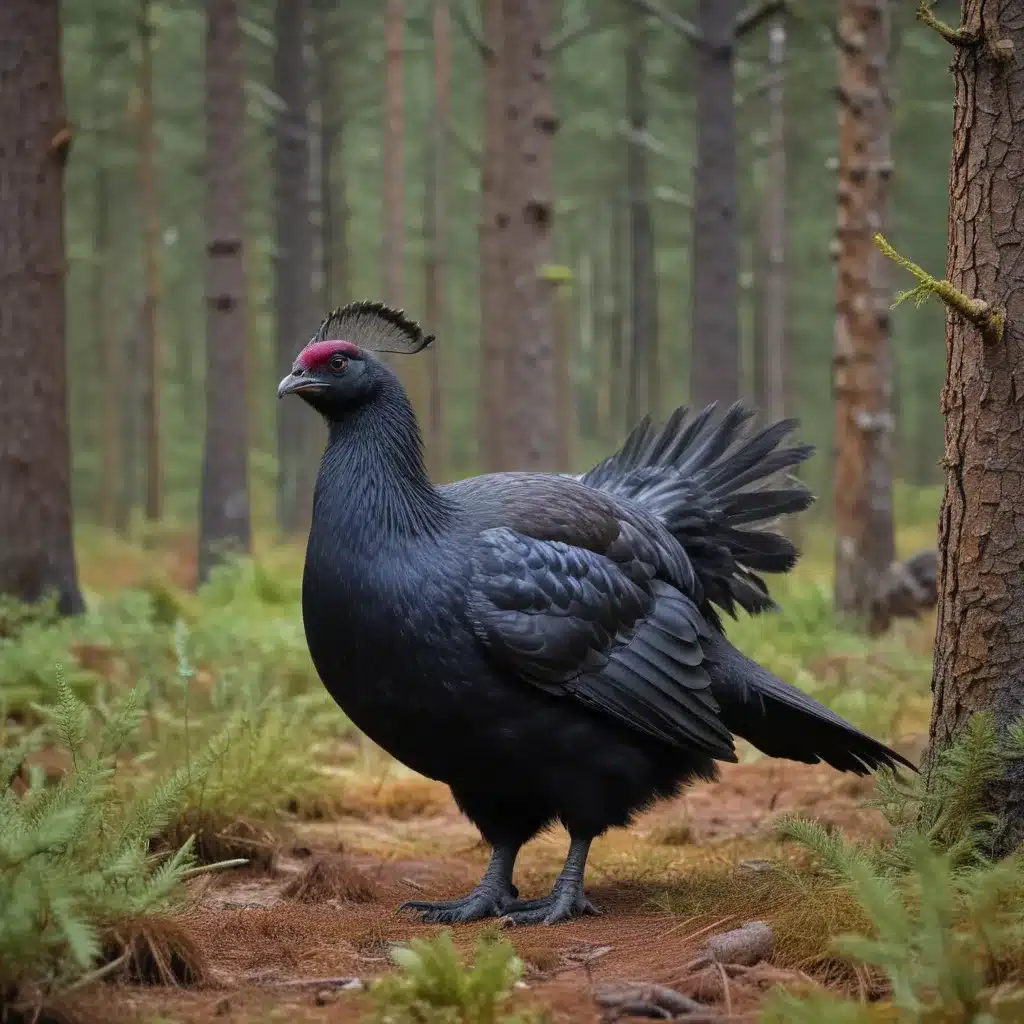
A Mystical Encounter in the Highlands
I’ve always been enamored by the rugged, untamed beauty of the Scottish Highlands. There’s just something so captivating about the towering mountains, the shimmering lochs, and the ancient forests that seem to whisper secrets of a bygone era. It was during one of my recent hiking trips to the Loch Ness Shores campsite that I had an encounter that would leave an indelible mark on my soul.
As I ventured deeper into the old pine woods, the air grew thick with the scent of moss and the earthy aroma of decomposing leaves. The sunlight filtered through the canopy, casting a warm, golden glow on the forest floor. I followed a winding trail, my footsteps muffled by the soft carpet of needles and twigs.
Suddenly, a movement in the distance caught my eye. There, perched on a fallen log, was a sight so breathtaking, it almost seemed unreal. It was a capercaillie, the magnificent and elusive bird that had become the stuff of legend in these parts. Its iridescent plumage shimmered in the dappled light, and its massive, curved beak seemed to command respect from the very trees that surrounded it.
The Mysterious Capercaillie
The capercaillie, or Tetrao urogallus, is a truly remarkable creature. Also known as the “giant grouse,” these birds are the largest members of the grouse family, with males weighing in at a whopping 8-12 pounds. Their impressive size and striking appearance have earned them a reputation as the “kings of the forest” in the Highlands.
What makes the capercaillie even more intriguing is its reclusive nature. These birds are notoriously shy and elusive, preferring to remain hidden deep within the ancient pine forests that they call home. Sightings are rare, and catching a glimpse of one in the wild is considered a true privilege.
As I stood there, transfixed by the bird’s presence, I couldn’t help but feel a sense of wonder and reverence. It was as if I had stumbled upon a mythical creature, a living embodiment of the Highlands’ timeless beauty and resilience.
The Plight of the Capercaillie
Sadly, the capercaillie’s future in the Highlands is far from certain. Over the past century, their population has dwindled alarmingly, with estimates suggesting that there are only around 1,000 individuals left in the wild. According to the RSPB, the main threats facing the capercaillie include habitat loss, predation, and disturbance from human activities.
As the ancient pine forests that the capercaillie relies on are fragmented and degraded, the birds are finding it increasingly difficult to thrive. Predators like foxes and crows have also taken a heavy toll on their vulnerable populations. And with growing numbers of visitors to the Highlands, the capercaillie’s peace and quiet is constantly under threat.
It’s a heartbreaking situation, but there is still hope. Conservation efforts are underway to protect and restore the capercaillie’s habitat, and organizations like the Scottish Wildlife Trust are working tirelessly to safeguard the future of this iconic species.
Preserving the Old Pine Woods
As I made my way back to the Loch Ness Shores campsite, I couldn’t help but reflect on the importance of protecting the old pine woods that the capercaillie calls home. These ancient forests are not just the domain of the elusive bird; they are the very heart and soul of the Highlands, a living testament to the region’s rich history and natural heritage.
It’s crucial that we, as visitors and stewards of this land, do our part to ensure that the capercaillie and its habitat are preserved for generations to come. This means being mindful of our impact, respecting the fragility of the ecosystem, and supporting conservation efforts that aim to restore and protect these incredible ecosystems.
By doing so, we can help ensure that the rare and magnificent capercaillie continues to grace the old pine woods of the Scottish Highlands, a symbol of the wild, untamed beauty that has captivated the hearts and imaginations of so many.
Encountering the Capercaillie: A Personal Reflection
As I sit here, reflecting on my chance encounter with the capercaillie, I can’t help but feel a sense of awe and humility. In a world that is often loud and chaotic, this fleeting moment of connection with a creature so ancient and mysterious was a powerful reminder of the magic that still exists in the natural world.
There was something about the capercaillie’s regal bearing, its unwavering presence in the midst of the towering pines, that filled me with a deep sense of reverence. It was as if the bird was imparting a timeless wisdom, a message that resonated deep within my soul.
Perhaps it was a reminder to slow down, to truly see and appreciate the wonders that surround us. Or maybe it was a call to action, an invitation to become a steward of these precious habitats and the creatures that call them home.
Whatever the case may be, I know that this experience has left an indelible mark on me. Whenever I return to the Loch Ness Shores campsite, I’ll be sure to keep my eyes peeled for that magnificent, iridescent figure, a symbol of the Highlands’ enduring magic and the importance of preserving its wild, untamed beauty.

